Sesame seeds and oil have been widely used in cooking and traditional medicine since ancient times. For example, in ancient Rome, plant seeds were considered a remedy for male impotence, and in Assyrian and Babylonian myths sesame wine was a drink of the gods. About how sesame grows and whether it can be grown in the country, in the material below.
Material Content:
What does a sesame plant look like?
Sesame is a genus of plants in Latin called Sesamum. From here comes the second name of the genus - sesame. The famous fairy tale spell "Open Sesame", apparently, has to do with the eastern legends of magic grass that can open castles.
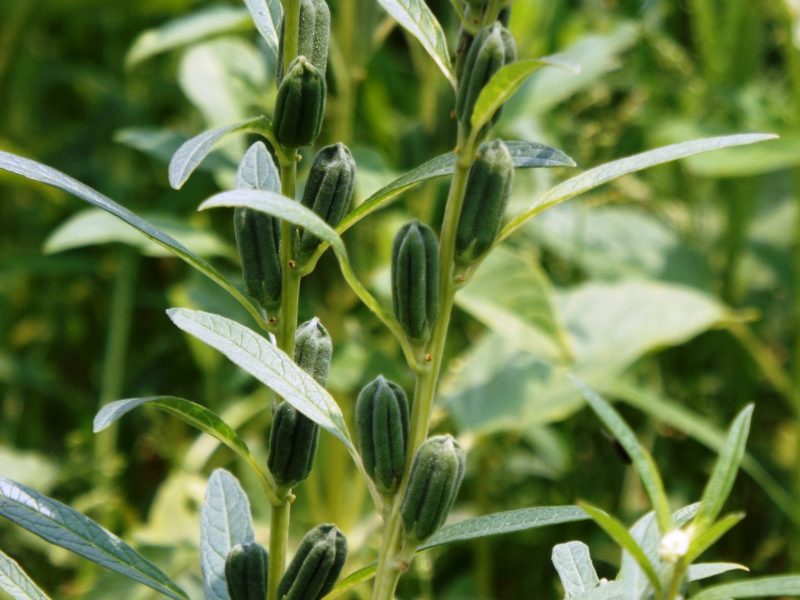
All sesame are herbaceous annuals or perennials. Since there are many forms, it is difficult to unambiguously describe what a sesame plant looks like.
As a rule, it has one powerful vertical stalk, but some species are able to branch. The leaves have a saturated green color, located opposite or in turn. In the leaf sinuses along the entire height of the stem are flowers with a bell-shaped or funnel-shaped nimbus. From them subsequently ripen fruit boxes with small seeds.
Types and varieties of sesame seeds
The genus Sesamum combines more than 20 different species. But only one of them entered the culture as a valuable oil plant - Indian sesame (Sesamum indicum).

Indian sesame is a vigorous annual. Its stem has a slight pubescence, and the flowers are pinkish, white or lilac in color. Each box ripens from 60 to 80 seeds. In the nests of the box they are stacked in "piles".
To date, the State Register of Breeding Achievements lists only 2 varieties approved for cultivation in Russia:
| Grade name | Precocity | Seed characteristics | Sustainability |
|---|---|---|---|
| Vizier | Mid-season | Rounded, cream | Resistant to drought and acacia grains |
| Solar | Early ripening | Rounded yellow | Resistant to drought, bacteriosis |
Early maturity and resistance to soil and climatic conditions is a very important factor. It is noted that the adaptive properties of Indian sesame seeds are rather weak. So, for example, plant ecotypes that successfully grow in arid regions of Central Asia do not take root in the humid climate of the North Caucasus. Therefore, when choosing seeds for sowing, it is necessary to take into account the recommendations on the growing zone.
Natural habitat: where and how it grows
Indian sesame, in fact, is of African descent. In its natural environment, it grows in the southeast of the continent, in the zone of humid subtropics. This plant was introduced to India during the time of the great geographical discoveries. Similar climatic conditions allowed sesame seeds to successfully take root in a new place, and India is now the main region for its industrial cultivation.
It is interesting: useful properties of sesame seeds
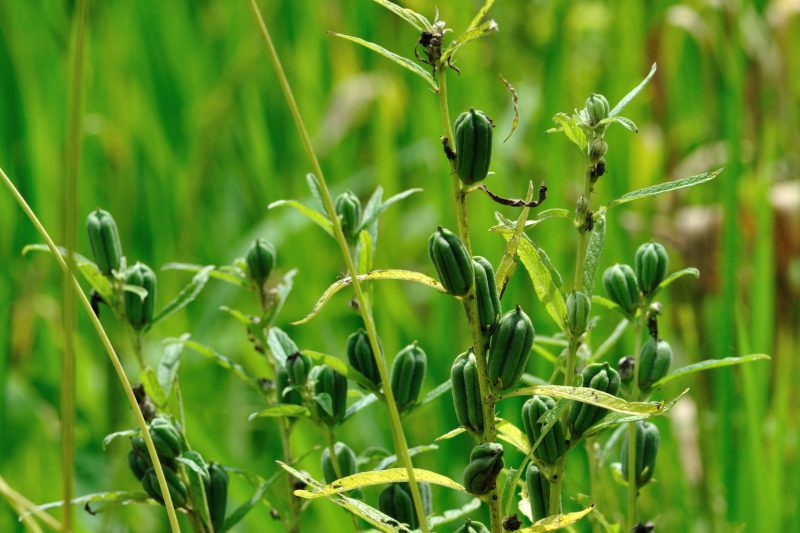
Countries where sesame grows are located at different points on the planet:
- Southeast Asia (India, Pakistan, Burma, China) - 70% of the sown area;
- Africa (Sudan, Nigeria, Sierra - Lyon, Ethiopia) - 23% of the cultivated area;
- North and South America (Guatemala, Venezuela, Mexico) - 7% of the cultivated area.
In Europe, sesame is cultivated in small volumes. In Russia, they began to sow fields with this crop quite recently - mainly in the Krasnodar Territory and the North Caucasus.
Growing sesame seeds in the garden

An analysis of the natural conditions in which Indian sesame was formed as a species gives a general idea of the ecological characteristics of the plant:
- High demands on heat. The optimal average daily temperature necessary for the formation of the vegetative mass is from +22 to +25 C. During the flowering and fruit formation period, the need for heat increases, and cooling can cause a massive discharge of buds and ovaries.
- High need for moisture. Since sesame is a subtropical plant, even its drought tolerant varieties are sensitive to air and soil humidity. With a lack of irrigation, the fruit set rate drops sharply and crop yields decrease.
- High demands on soil fertility. High humus chernozems, chestnut soils, light structural loams, sandy loams are optimal for sesame cultivation. Unsuitable heavy cold clay soils, swampy and saline, low humus sandy and peaty soils.
All these requirements must be considered before sowing on the garden plot.
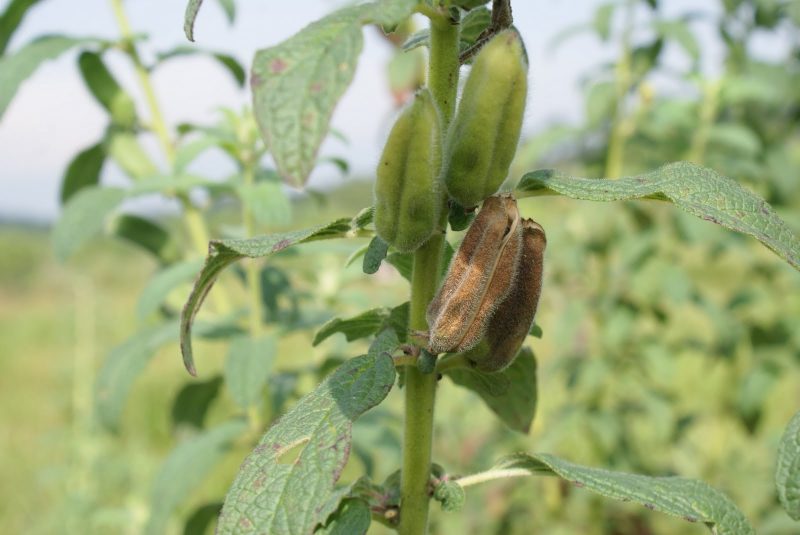
Agricultural technology of its sowing includes the following activities:
- presowing seed dressing with a weak solution of potassium permanganate;
- sowing in soil, heated at a depth of 10 cm to a temperature of 16-18 C;
- Seeding of seeds to a depth of 3-4 cm and thorough watering until emergence.
Sowing sesame seeds is done in rows, the interval between which should be at least 50 cm. Seeding rate - 1 g of seeds per 1 square meter. If the air temperature is unstable, crops must be protected with a spanbond.
Basic care rules
Under favorable conditions, sesame seed germinates quickly - for 3-5 days.

After the emergence of seedlings, two mandatory operations are performed:
- thinning - between shoots in a row 6-10 cm are left;
- mulching - the topsoil is covered, both between seedlings and between rows.
For mulching sesame seeds, it is better to choose organic, quickly degradable mulch - small straw section, peat, compost, mowed grass.
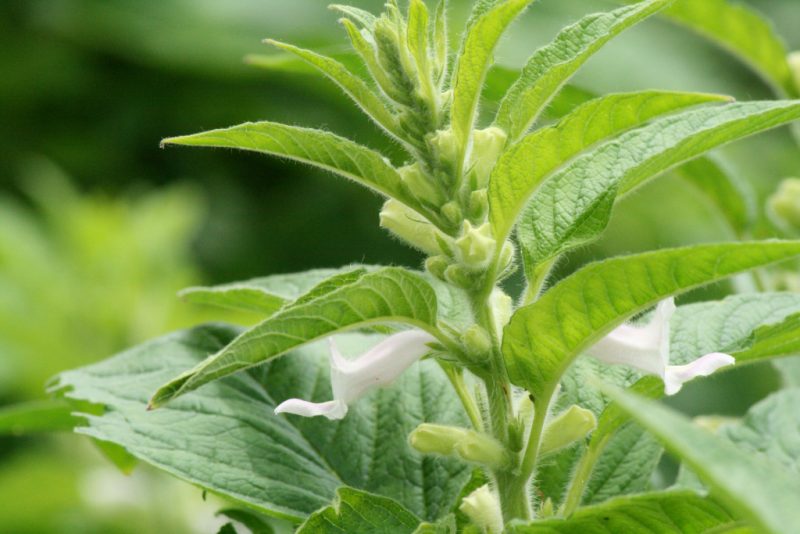
These materials will help to achieve four goals simultaneously:
- Protection of the topsoil from drying out. The root system of seedlings develops slowly, is located at a shallow depth and quickly dies from a lack of moisture. Mulch does not allow irrigation water to evaporate quickly, sintering the soil into a crust.
- Natural carbon dioxide top dressing. Plants build up vegetative mass by absorbing carbon dioxide from the air. Organic mulch, decomposing, excretes it directly under the plants.
- Increased activity of soil flora. Under the mulch layer, a favorable environment is created for the reproduction of beneficial bacteria, many of which are antagonists for various pathogenic fungi. Also increases the activity of earthworms and predatory insects eating pests.
- Maintaining a constant soil temperature. Under the mulch, the soil will neither overcool nor overheat. A stable temperature in the root zone allows the plant to normally absorb nutrients from the soil.
When the budding phase begins, the plant must be fed. There are no special fertilizers for this crop in Russia, so you need to focus on the ratio of nitrogen, phosphorus and potassium.
It should be as follows:
- nitrogen (N) - 20;
- phosphorus (P) - 30;
- potassium (K) - 30.
Feeding is better in liquid form, accompanying it with abundant watering. It is also important during periods of budding, flowering and fruit ripening to carefully monitor the soil moisture.
Read also:sesame oil - beneficial properties and contraindications
Collection and storage of sesame seeds
You can determine the ripening moment by a number of external signs:
- yellowing of the plant;
- drying of the lower leaves;
- drying boxes.
However, harvesting can be difficult because the boxes on the stem do not ripen at the same time - the lower ones are faster than the upper ones. Therefore, mowing is started only after the cracking of the lowermost boxes begins.
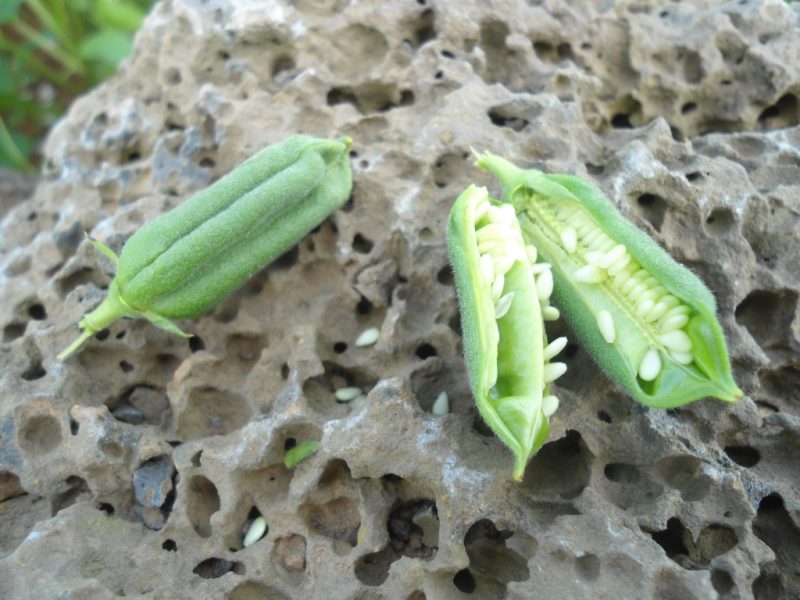
Mowed sesame stalks are laid out on a clean sheet and the boxes are carefully removed. Then the stems are harvested, and the fruits are dried. Fully dried boxes open easily with your fingers, and the seeds spill out into your hand.
It is better to store sesame seeds in a form that is not cleaned from the outer shell. To ensure optimal storage conditions of the product, you need to pour the seeds into paper bags, close tightly and put in a dry unheated room. At a temperature close to 0 ° C, the seeds are well preserved for six months.
Sesame is not only suitable for culinary purposes. Traditional medicine notes its healing properties. Therefore, its independent cultivation in the garden, although it is associated with high labor costs, but pays off for the benefits that the plant brings.












